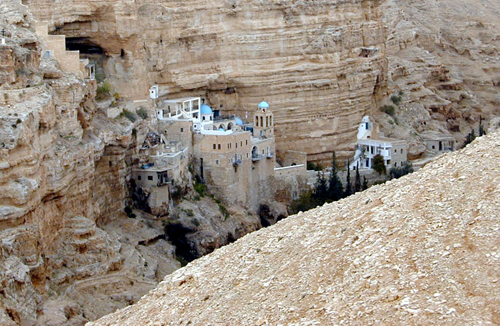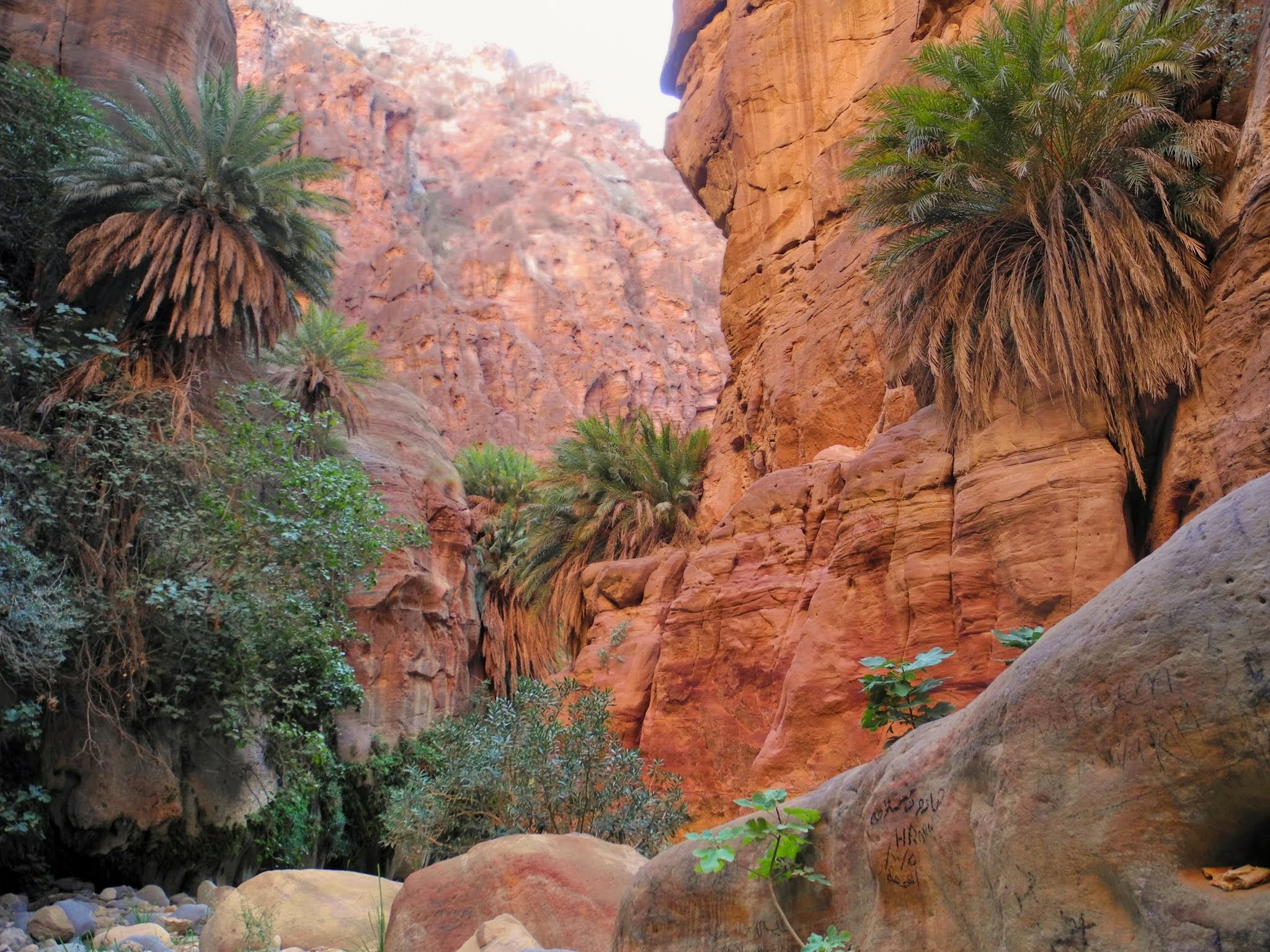|
St. George's Monastery, Wadi Qelt
The Monastery of Saint George of Choziba (, , ''lit.'' Monastery of Saint George the Hozevite), also known as Monastery of Choziba (or Hoziba) or Mar Jaris, is a monastery located in Wadi Qelt in Area C of the eastern West Bank, in the Jericho Governorate of the Palestinian Authority . The cliff-hanging complex, which emerged from a lavra established in the 420s and reorganised as a monastery around AD 500, with its ancient chapel and irrigated gardens, is active and inhabited by Greek Orthodox monks. It houses the relics of Saint George of Choziba, after whom the monastery is named, as well as the relics of Saint John of Choziba (420/450–520/530) and those of (1913–1960). The monastery is reached by a pedestrian bridge across Wadi Qelt, which many believe to be Psalm 23's "valley of the shadow of death". The valley parallels the old Roman road to Jericho, the backdrop for the parable of the Good Samaritan (). The monastery is open to pilgrims and visitors. Established ... [...More Info...] [...Related Items...] OR: [Wikipedia] [Google] [Baidu] |
Area C (West Bank)
Area C (; ) is the fully Israeli-controlled territory in the West Bank, defined as the whole area outside the Palestinian enclaves (Areas A and B). Area C constitutes about 61 percent of the West Bank territory, containing most Israeli settlements other than those in East Jerusalem, and more than 99% of the area is off limits or heavily restricted for Palestinians. The area was committed in 1995 under West_Bank_Areas_in_the_Oslo_II_Accord, the Oslo II Accord to be "gradually transferred to Palestinian jurisdiction" (with an option for land swaps under a final agreement), but such transfer did not happen. The area is richly endowed with natural resources. Area C, along with the rest of the West Bank, has been under Israeli military control since 1967. In 2023, Area C was home to 491,548 Israeli settlers, and 354,000 Palestinians. The Jewish population in Area C is administered by the Israeli Judea and Samaria Area administration, into which Israeli law in the West Bank settleme ... [...More Info...] [...Related Items...] OR: [Wikipedia] [Google] [Baidu] |
George Of Koziba
Saint George of Choziba, also called George the Chozibite or Chozebite (died c. 625), was a Greek Cypriot monk and leader of the monastery of Choziba in the vicinity of Jerusalem. Today, the monastery is named after George. George was born on Cyprus and orphaned at a young age. He was raised in a monastery under one of his uncles. His older brother joined the ''lavra'' of Calamon in the Jordan Valley, but George's request for admission was rejected and he was sent to the coenobium of Choziba, which had been founded around 480 by John of Thebes. According to his biographer, George and his brother abstained from wine in the ''lavra'' of Calamon and in Choziba. From Saturday evening until Sunday afternoon, George would observe an all-night vigil in the coenobium of his monastery; otherwise he and his fellow monks lived in their cells. In 614, when the Persians invaded Palestine and sacked Jerusalem, George remained at Choziba. A likeness of George is among the 36 saints (mostly ... [...More Info...] [...Related Items...] OR: [Wikipedia] [Google] [Baidu] |
John Of Thebes
Saint John of Choziba, originally known as John of Thebes, was a monk who was born in Egypt around the year 440–450 CE. He abandoned monophysitism around 480 and moved to Wadi Qelt, a wadi in the Judaean Desert, where he reorganized the existing lavra into a monastery known as the monastery of Choziba. In 516, he became Bishop of Caesarea, but soon resigned and returned to the monastery of Choziba, where he died between 520 and 530. He has been canonised Canonization is the declaration of a deceased person as an officially recognized saint, specifically, the official act of a Christian communion declaring a person worthy of public veneration and entering their name in the canon catalogue of sai ... as Saint John of Choziba. References 440s births 520s deaths 5th-century Byzantine monks 6th-century Byzantine monks 5th-century Egyptian people 6th-century Egyptian people 6th-century Syrian bishops 6th-century Christian saints Saints from the Holy Land Bishops of ... [...More Info...] [...Related Items...] OR: [Wikipedia] [Google] [Baidu] |
Hasmonean Royal Winter Palaces
The Hasmonean and Herodian royal winter palaces, or the Hasmonean and Herodian palaces at Jericho, are a complex of Hasmonean and Herodian buildings from the Second Temple period, which were discovered in the western plain of Jericho valley, at Tulul Abu el-'Alayiq, near the place where the Roman road connecting Jericho with Jerusalem enters Wadi Qelt. Two tells are located on either side of Wadi Qelt. The palaces are evidence of the luxurious lifestyle of the Hasmonean dynasty and Herod the Great. They made extensive use of swimming pools, bathhouses, ornamental gardens and orchards. The palaces were not far from Jerusalem – 20 km along the ancient Roman road (see "ascent of Adummim"). History of excavations The site was excavated in the 19th century by Charles Warren, who attempted to locate the place of Biblical Jericho. After making an archaeological trench, he concluded that this site is from the Roman period. Additional excavations were conducted by the ... [...More Info...] [...Related Items...] OR: [Wikipedia] [Google] [Baidu] |
Wadi
Wadi ( ; ) is a river valley or a wet (ephemerality, ephemeral) Stream bed, riverbed that contains water only when heavy rain occurs. Wadis are located on gently sloping, nearly flat parts of deserts; commonly they begin on the distal portions of alluvial fans and extend to inland sabkhas or dry lakes. Permanent channels do not exist, due to lack of continual water flow. Water percolates down into the stream bed, causing an abrupt loss of energy and resulting in vast deposition. Wadis may develop dams of sediment that change the stream patterns in the next flash flood. Wadis tend to be associated with centers of human population because sub-surface water is sometimes available in them. Nomadic and pastoral desert peoples will rely on seasonal vegetation found in wadis, even in regions as dry as the Sahara, as they travel in complex transhumance routes. The centrality of wadis to water – and human life – in desert environments gave birth to the distinct sub-field of wadi h ... [...More Info...] [...Related Items...] OR: [Wikipedia] [Google] [Baidu] |
Mitzpe Yericho
Mitzpe Yeriho, also spelled Mitzpeh Yericho (, ''lit.'' Jericho Lookout), is a religious Israeli settlement in the West Bank, located next to the Palestinian city of Jericho, from where it gets its name. Located 20 km east of Jerusalem and 10 km east of Ma'ale Adumim along Highway 1 in the Judean Desert, it is organised as a community settlement and falls under the jurisdiction of Mateh Binyamin Regional Council. In it had a population of . The international community considers Israeli settlements in the West Bank illegal under international law, but the Israeli government disputes this. Geography The village lies on one of the last cliffs marking the edge of the Judean highlands, and overlooks the Jordan Rift Valley, the Dead Sea, and the Palestinian city of Jericho, whence its name is derived. The climate is dry, with temperatures a few degrees warmer than Jerusalem temperatures all year round. History Founded in October 1977 during the Jewish holiday of Sukk ... [...More Info...] [...Related Items...] OR: [Wikipedia] [Google] [Baidu] |
Israel
Israel, officially the State of Israel, is a country in West Asia. It Borders of Israel, shares borders with Lebanon to the north, Syria to the north-east, Jordan to the east, Egypt to the south-west, and the Mediterranean Sea to the west. Israeli-occupied territories, It occupies the Occupied Palestinian territories, Palestinian territories of the West Bank in the east and the Gaza Strip in the south-west. Israel also has a small coastline on the Red Sea at its southernmost point, and part of the Dead Sea lies along its eastern border. Status of Jerusalem, Its proclaimed capital is Jerusalem, while Tel Aviv is the country's Gush Dan, largest urban area and Economy of Israel, economic center. Israel is located in a region known as the Land of Israel, synonymous with the Palestine (region), Palestine region, the Holy Land, and Canaan. In antiquity, it was home to the Canaanite civilisation followed by the History of ancient Israel and Judah, kingdoms of Israel and Judah. Situate ... [...More Info...] [...Related Items...] OR: [Wikipedia] [Google] [Baidu] |
State Of Palestine
Palestine, officially the State of Palestine, is a country in West Asia. Recognized by International recognition of Palestine, 147 of the UN's 193 member states, it encompasses the Israeli-occupied West Bank, including East Jerusalem, and the Gaza Strip, collectively known as the occupied Palestinian territories, within the broader geographic and historical Palestine (region), Palestine region. Palestine shares most of its borders with Israel, and it borders Jordan to the east and Egypt to the southwest. It has a total land area of while Demographics of the State of Palestine, its population exceeds five million people. Its Status of Jerusalem, proclaimed capital is Jerusalem, while Ramallah serves as its administrative center. Gaza City was its largest city prior to Gaza Strip evacuations, evacuations in 2023. Situated at a Levantine corridor, continental crossroad, the region of Palestine was ruled by various empires and experienced Demographic history of Palestine (region ... [...More Info...] [...Related Items...] OR: [Wikipedia] [Google] [Baidu] |
Saint George
Saint George (;Geʽez: ጊዮርጊስ, , ka, გიორგი, , , died 23 April 303), also George of Lydda, was an early Christian martyr who is venerated as a saint in Christianity. According to holy tradition, he was a soldier in the Roman army. Of Cappadocian Greek origin, he became a member of the Praetorian Guard for Roman emperor Diocletian, but was sentenced to death for refusing to recant his Christian faith. He became one of the most venerated saints, heroes, and megalomartyrs in Christianity, and he has been especially venerated as a military saint since the Crusades. He is respected by Christians, Druze, as well as some Muslims as a martyr of monotheistic faith. In hagiography, he is immortalised in the legend of Saint George and the Dragon and as one of the most prominent military saints. In Roman Catholicism, he is also venerated as one of the Fourteen Holy Helpers. His feast day, Saint George's Day, is traditionally celebrated on 23 April. Historic ... [...More Info...] [...Related Items...] OR: [Wikipedia] [Google] [Baidu] |
Greek Language
Greek (, ; , ) is an Indo-European languages, Indo-European language, constituting an independent Hellenic languages, Hellenic branch within the Indo-European language family. It is native to Greece, Cyprus, Italy (in Calabria and Salento), southern Albania, and other regions of the Balkans, Caucasus, the Black Sea coast, Asia Minor, and the Eastern Mediterranean. It has the list of languages by first written accounts, longest documented history of any Indo-European language, spanning at least 3,400 years of written records. Its writing system is the Greek alphabet, which has been used for approximately 2,800 years; previously, Greek was recorded in writing systems such as Linear B and the Cypriot syllabary. The Greek language holds a very important place in the history of the Western world. Beginning with the epics of Homer, ancient Greek literature includes many works of lasting importance in the European canon. Greek is also the language in which many of the foundational texts ... [...More Info...] [...Related Items...] OR: [Wikipedia] [Google] [Baidu] |





